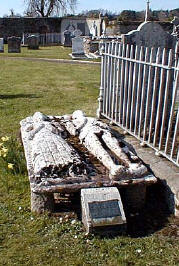|
Kildare Families
The Eustace Family of Kilcullen By Major-General Sir-Eustace F. Tickell (Journal of the County Kildare Archaeological Society; Volume XI1I, No. 6 pp. 390-391 (1955) Kilcullen. The Eustaces do not appear to have owned, except for short periods, any land west of the Kilcullen-Athy road, but doubtless Old Kilcullen was the family burial ground before the little chapels were built at Castlemartin and Coghlanstown. The ancient crosses in Old Kilcullen churchyard of course date from before the days of the Eustaces, but there was the effigy of a Eustace knight in the church. This will be described presently. A walled enclosure near the church containing buildings known as the Old Manor House of Kilcullen, was forfeited after the Baltinglass rebellion. It was probably connected with the Barony of Kilcullen, held by the three Viscounts. Old Kilcullen had been an important town, but after the building of the bridge in 1319 it slowly gave place to the present village, most of which formed part of the Castlemartin property, together with the tolls at the six-monthly fairs. The fairs were originally held annually on St. Barnabas Day, the tolls being first granted to William Eustace of Castlemartin in 1606. During the nineteenth century part of the northern end of the village, including the toll-house was owned by the Tickell family. Old Kilcullen church is now in ruins, but was in use as late as 1792. Nicholastown, just south of Kilcullen Bridge, was included in the Castlemartin estates of Arnold FitzEustace Le Poer in 1317 but was donated as part of the lands of the New Abbey of Grey Friars founded in 1486 by Baron Portlester. Nicholastown was forfeited by Pierce FitzGerald after the 1641 rebellion. New Abbey was not complete when Portlester died in 1496, but his daughter Alison, Countess of Kildare and he himself were buried in the chapel. The abbey was finished by his nephew the 1st Viscount Baltinglass, but its life was very short, for in 1539 it was dissolved by Henry VIII. The buildings were intact in 1540, but a few years later were in ruins. These consisted of the walls only of the chapel, belfry, dining hall, dorm kitchen and two other rooms. The lands had been reduced to a mere eight acres. It was leased to the 1st Viscount who died there in 1549, and the lease was still held by his son eleven years later. One would strongly suspect that these ardent Catholics maintained it as a religious house sub rosa. New Abbey was forfeited in 1582 and was let to the poet Edmund Spenser, who had been Secretary to the Lord Deputy during the Baltinglass rebellion and was granted Kilcolman Castle, Co. Cork, with 3,000 acres, and other lands including the Baltinglass house in Dublin, but soon passed to Sir Henry Harrington and was owned by his son Sir John in 1612. It must have been repaired, for by about 1645 an old estate map shows both “New Abbey Steeple” and ‘New Abbey House.’ The steeple fell in 1764, and by 1782 only the refectory and walls of the cruciform confessional chapel remained. (The ruined chapel as it was in 1782, is illustrated in Vol.1 p. 307 of the Journal of the Kildare Archaeological Society, from a sketch by Austin Cooper.) Soon afterwards the chapel was demolished and rebuilt, but whether on the same site is not known. This chapel was itself demolished (except for the dwarf walls, which now remain) when the present Catholic church was built in 1873.
New Abbey Effigy of Roland & Margaret FitzEustace
The New Abbey effigy of Lord Portlester and his wife Margaret D’Artois was in the original chapel, but now lies out in the grave yard. As is the case with many old monuments, both in England and Ireland, the rain-water that collects in the hollows of the carving is said to possess mystic healing properties, but at New Abbey these do not appear to extend to the rapidly weathering stonework itself. According to local tradition the effigy is over the actual grave, but I think that this is very unlikely. Portlester lies with his head on a square pillow and his feet against a dog. He is in plate armour but with a gorget of chain-mail protecting his head and shoulders. (It may be that the plate armour was worn over a chain-mail habergeon reaching down to the thighs, as appears to be the cast with the St. Audoen’s effigy.) He has a conical helmet apparently without crest or vizor. The cross-hilt of his heavy sword curves down at the ends. Margaret wears a pleated dress, belted at the waist, and the horned head-dress of the period. The inscription is now illegible, but was almost certainly very similar to that on the St. Audoen’s effigy described below. (An old manuscript gives the inscription as . . . fz Eustace miles Ds de Portlester nuper…Hib: et Margareta Janico uxor eius et fabricatores hui’ monast’: quor animab’ propitiet Deus Amen). In 1873 the panels of the altar-tomb on which the effigy originally lay were collected and built into the dwarf-walls of the ruined chapel, hut are now obscured by modern tombstones. The carving on the panels represents various religious figures and motifs, including emblems of the Passion and Crucifixion. One panel bears the arms of Portlester, quartering those of his widow, who had been an heiress. (The arms, as carved, are: “1 & 4, a saltire with annulet for cadency (i.e. a fifth son), 2 & 3, barry of six.” The D’Artois arms were actually--Barry wavy of six, argent and gules.” These pages © Ronald Eustice, 2007 |

